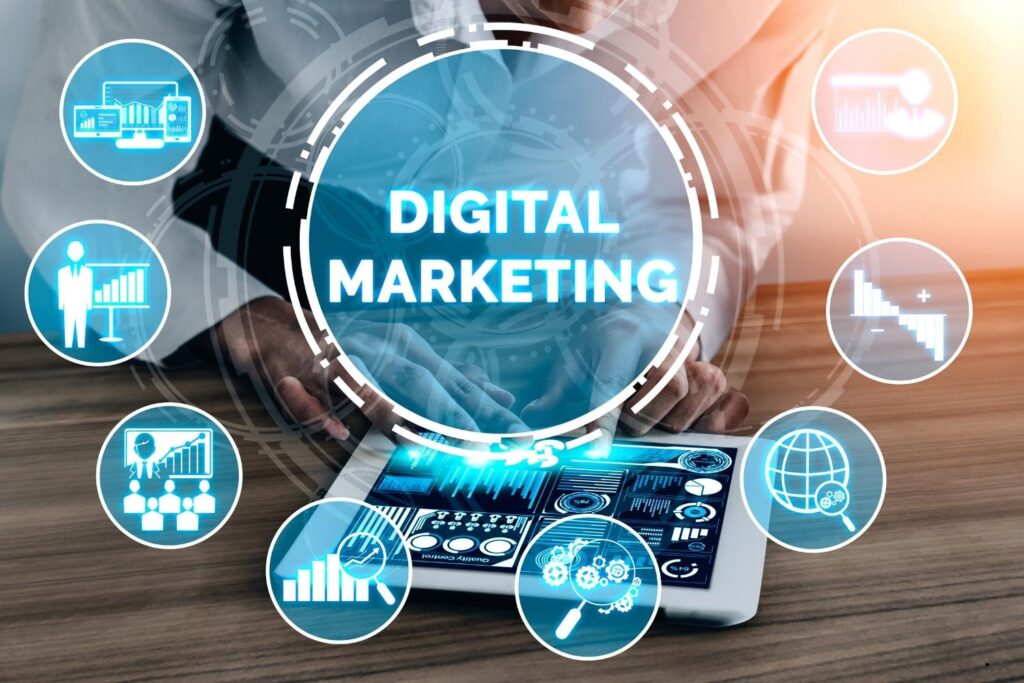
Digital marketing is the process of promoting and selling products or services using online and digital technologies like the internet, mobile phones, social media, and search engines. It utilizes various channels such as websites, email, search engine optimization (SEO), social media, and paid advertising to reach and engage potential customers, build brand awareness, and drive sales. This dynamic approach offers two-way communication, allowing businesses to interact with customers and analyze their behaviors in real-time, making it a powerful and adaptable part of modern business strategies.
Key Characteristics & Goals
- Utilizes Digital Channels:Instead of traditional media, it uses digital platforms like websites, apps, and social media to connect with audiences.
- Drives Engagement:It fosters two-way communication, enabling businesses to interact with customers, build relationships, and create loyalty.
- Facilitates Data Analysis:Digital marketing allows for the collection and analysis of data to understand customer behavior, target specific audiences, and tailor campaigns for better results.
- Cost-Effective:Digital channels can offer a cost-effective way to reach a wide audience and acquire new customers compared to some traditional marketing methods.
Common Digital Marketing Channels
- Search Engine Optimization (SEO): Optimizing a website to rank higher in search engine results.
- Pay-Per-Click (PPC) Advertising: Running paid ads on search engines and social media platforms.
- Social Media Marketing: Promoting products and engaging with customers on platforms like Facebook, Instagram, and LinkedIn.
- Email Marketing: Sending promotional content and newsletters to a targeted list of subscribers.
- Content Marketing: Creating and distributing valuable content like blog posts and videos to attract and retain an audience.
- Mobile Marketing: Marketing through mobile devices, including text messages and mobile-optimized websites.
Benefits
Digital marketing is the process of promoting and selling products or services using online and digital technologies like the internet, mobile phones, social media, and search engines. It utilizes various channels such as websites, email, search engine optimization (SEO), social media, and paid advertising to reach and engage potential customers, build brand awareness, and drive sales. This dynamic approach offers two-way communication, allowing businesses to interact with customers and analyze their behaviors in real-time, making it a powerful and adaptable part of modern business strategies.
Key Characteristics & Goals
- Utilizes Digital Channels:Instead of traditional media, it uses digital platforms like websites, apps, and social media to connect with audiences.
- Drives Engagement:It fosters two-way communication, enabling businesses to interact with customers, build relationships, and create loyalty.
- Facilitates Data Analysis:Digital marketing allows for the collection and analysis of data to understand customer behavior, target specific audiences, and tailor campaigns for better results.
- Cost-Effective:Digital channels can offer a cost-effective way to reach a wide audience and acquire new customers compared to some traditional marketing methods.
Common Digital Marketing Channels
- Search Engine Optimization (SEO): Optimizing a website to rank higher in search engine results.
- Pay-Per-Click (PPC) Advertising: Running paid ads on search engines and social media platforms.
- Social Media Marketing: Promoting products and engaging with customers on platforms like Facebook, Instagram, and LinkedIn.
- Email Marketing: Sending promotional content and newsletters to a targeted list of subscribers.
- Content Marketing: Creating and distributing valuable content like blog posts and videos to attract and retain an audience.
- Mobile Marketing: Marketing through mobile devices, including text messages and mobile-optimized websites.
Benefits
- Increased Brand Awareness: Reaches a wider audience and builds brand recognition.
- Improved Sales & Leads: Targets specific audiences, driving traffic and conversions.
- Better Customer Insights: Provides data on customer behavior, allowing for more effective marketing efforts.
- Greater Flexibility: The dynamic nature of digital channels allows for continuous optimization of campaigns.
